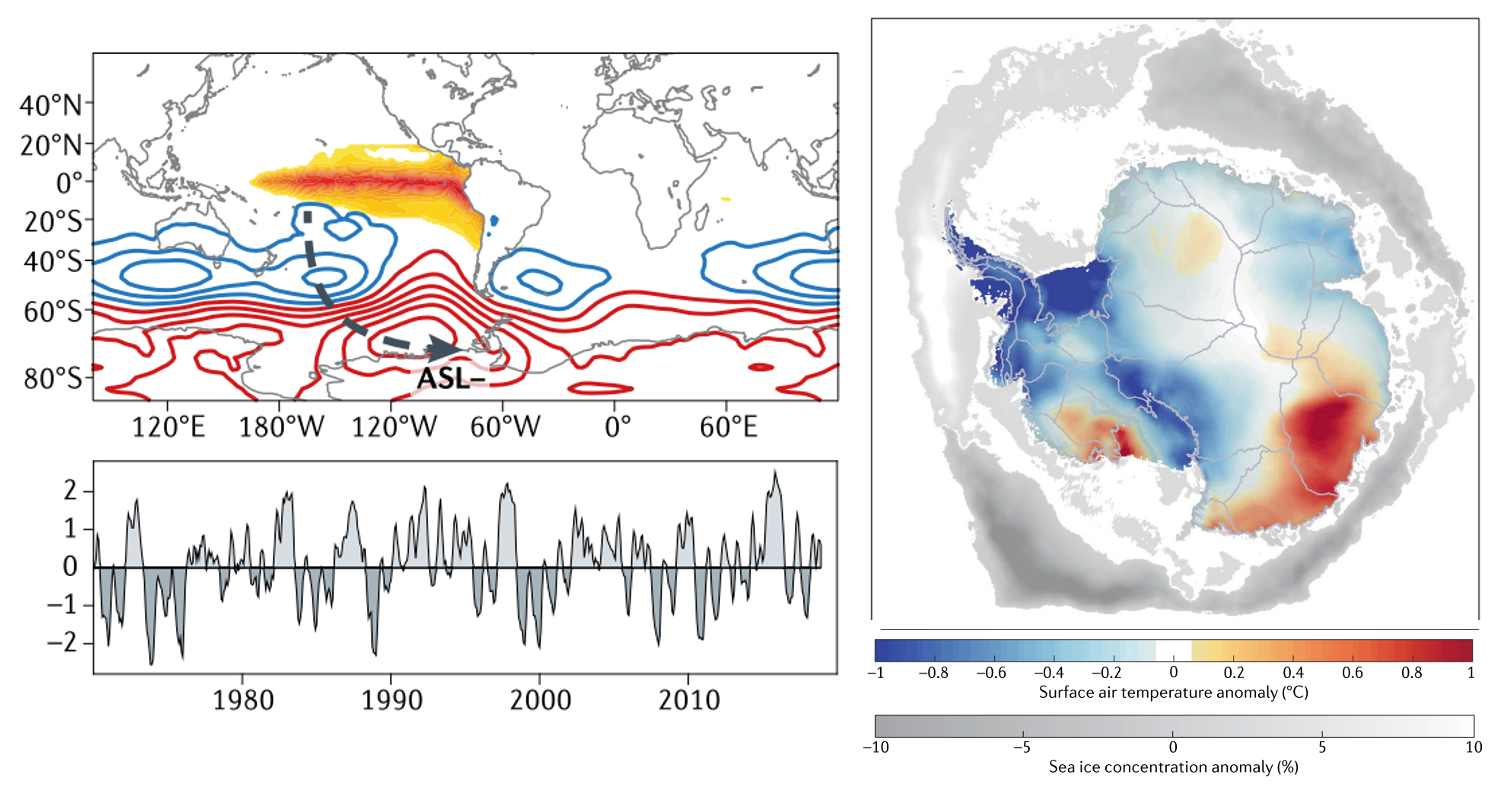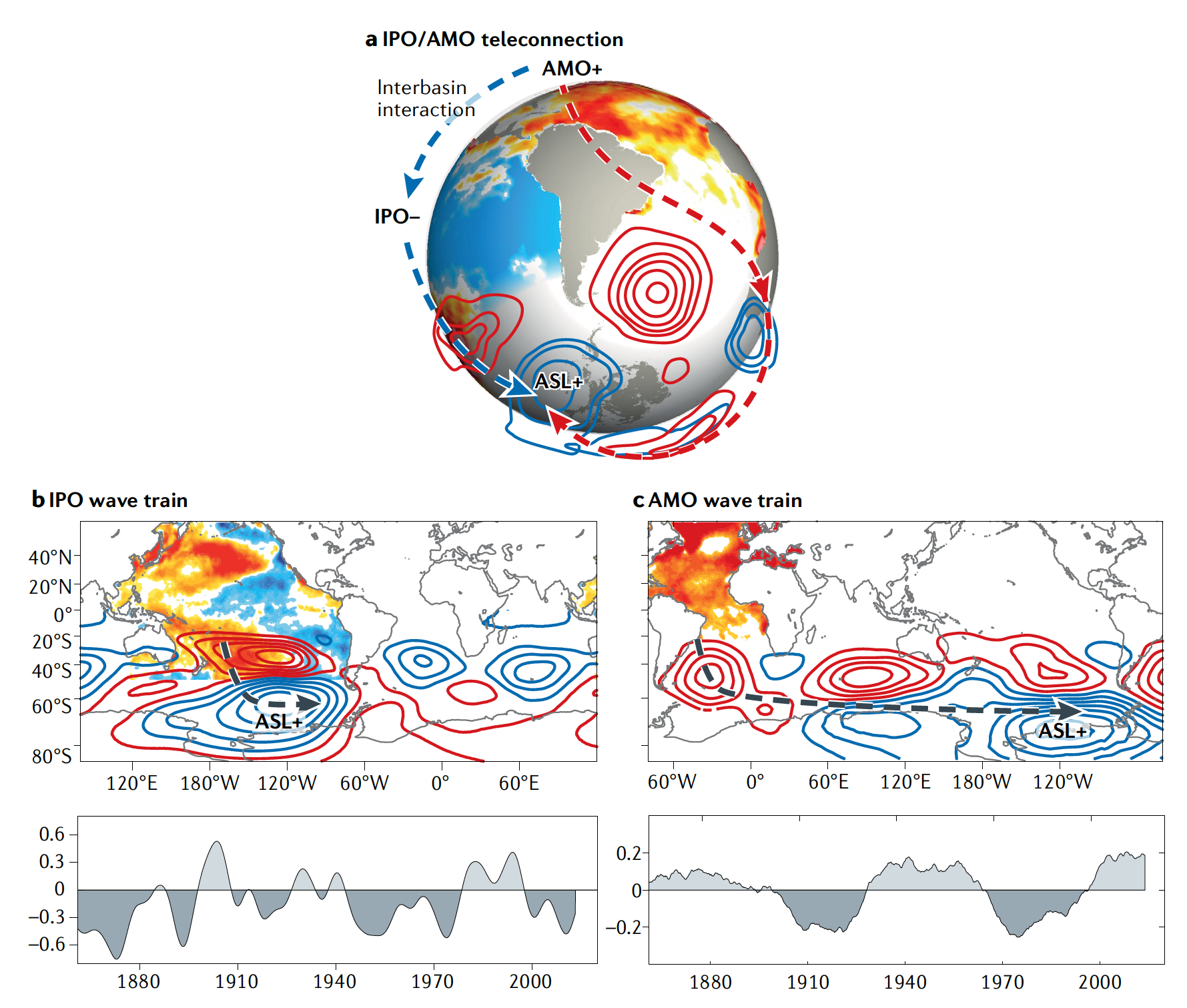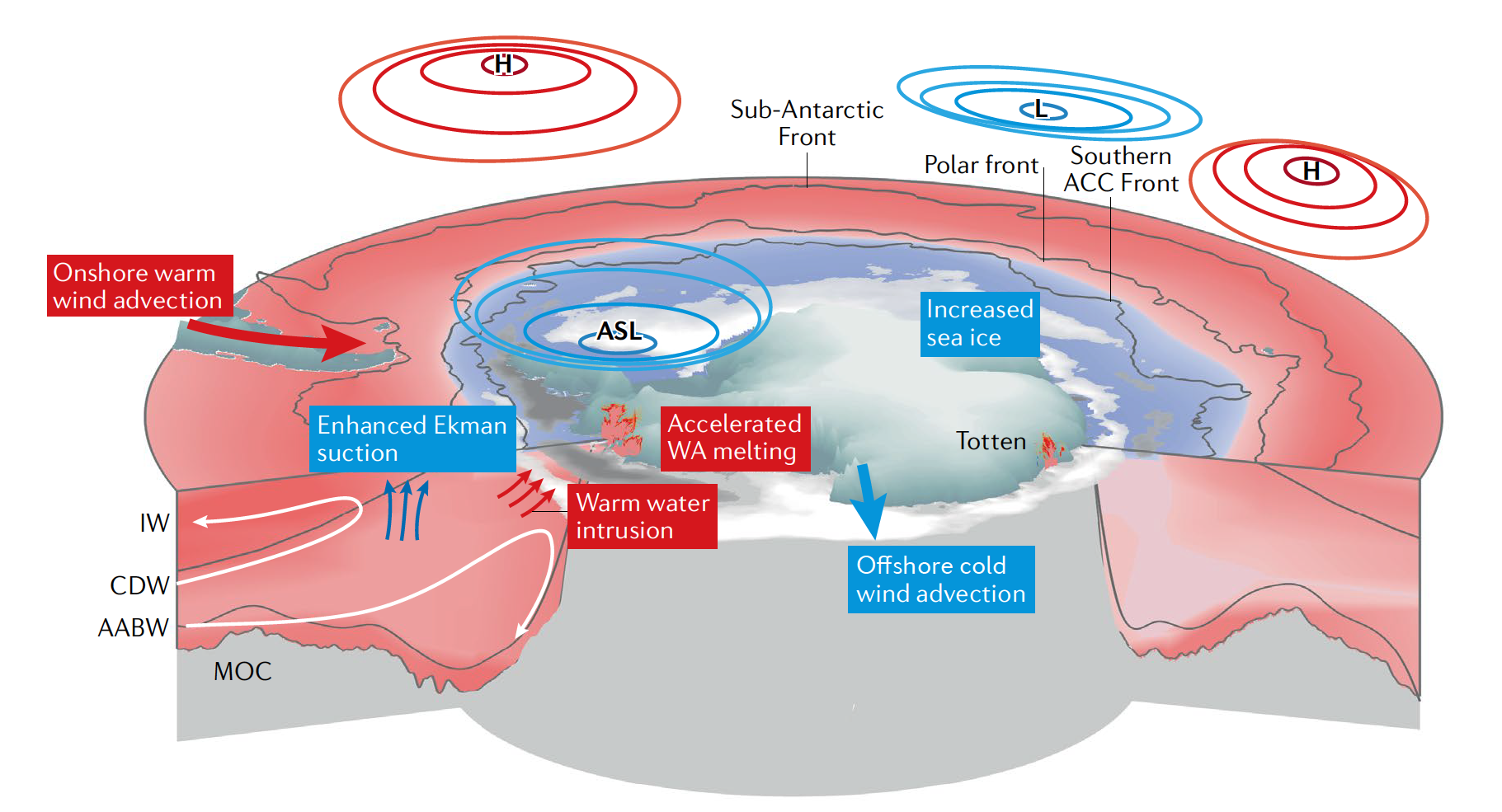Tropical Teleconnection Impacts on Antarctic Climate Changes
Scientists compiled a comprehensive review summarizing the current state of understanding about teleconnections between the climate of the tropics and that of Antarctica and the Southern Ocean.
The Science
Over the modern satellite era, substantial climatic changes have been observed in the Southern Ocean and the Antarctic. This study aims to summarize tropical teleconnections to the Southern Hemisphere high latitudes arising from the El Niño-Southern Oscillation (ENSO), the Interdecadal Pacific Oscillation (IPO), and the Atlantic Multidecadal Oscillation (AMO – Fig. 1). Particular focus is given to understanding the physical mechanisms of teleconnections and understanding their long-term climatic impacts. By synthesizing the results from numerous past studies, scientists found that tropical-to-polar teleconnections have contributed to the following Antarctic and Southern Ocean changes over the past few decades: regional rapid surface warming; pre-2015 sea ice expansion and its reduction thereafter; changes in ocean heat content; accelerated thinning of the Antarctic Ice Sheet.

Figure 1. Upper-left: 500-hPa geopotential height anomalies (red and blue contours indicating positive and negative anomalies) following positive June, July, August (JJA) El Niño–Southern Oscillation event (color shading). Lower-left: Time series of Niño 3.4 index. Right: JJA Antarctic surface air temperature (color) and sea ice concentration (grey scale) anomalies regressed onto the standardized JJA Niño 3.4 index. Tropical sea surface temperature variability promotes stationary Rossby wave propagation to the Southern Hemisphere; atmospheric pressure anomalies (e.g., Amundsen Sea Low, ASL), drive SAT and SIC anomalies.
The Impact
Limited observations and model biases restrict our understanding of the relative importance of teleconnections versus those arising from greenhouse gases, ozone recovery, and internal variability. Reducing these uncertainties and improving understanding requires pan-Antarctic efforts towards sustained, long-term observations and more realistic dynamics and parameterizations applied within high-resolution climate models.

Figure 2. Teleconnection patterns triggered by decadal sea surface temperature variability. a | Schematic representation of the atmospheric teleconnection patterns induced by a positive phase of the Atlantic Multidecadal Oscillation (AMO; red arrow) and a negative phase of the Interdecadal Pacific Oscillation (IPO; blue arrow). b | Austral winter (June, July, August) 500- hPa geopotential height anomalies (contours) associated with a negative phase of the IPO (shading) in the atmospheric model, NCAR CAM5. The pattern of sea surface temperature anomalies represents a one standard deviation negative IPO event. Red and blue contours indicate positive and negative pressure anomalies, respectively, drawn at intervals of 8 meters. The time series is that of the IPO index98. c | As in panel b but for a positive phase of the AMO. A positive phase of the AMO and a negative phase of the IPO both promote Rossby wave trains that deepen the Amundsen Sea Low (ASL). A positive AMO can also contribute to a negative phase of the IPO through interbasin interactions, complicating assessment of tropical–extratropical interactions.
Summary
Over the modern satellite era, substantial climatic changes have been observed in the Antarctic, including atmospheric and oceanic warming, ice sheet thinning and a general Antarctic-wide expansion of sea ice, followed by a more recent rapid loss. Although these changes, featuring strong zonal asymmetry, are partially influenced by increasing greenhouse gas emissions and stratospheric ozone depletion, tropical–polar teleconnections are believed to have a role through Rossby wave dynamics. The researchers synthesize understanding of tropical teleconnections to the Southern Hemisphere extratropics arising from the El Niño–Southern Oscillation, Interdecadal Pacific Oscillation and Atlantic Multidecadal Oscillation (Fig. 2), focusing on the mechanisms and long-term climatic impacts. These teleconnections have contributed to observed Antarctic and Southern Ocean changes (Fig. 3), including regional rapid surface warming, pre-2015 sea ice expansion and its sudden reduction thereafter, changes in ocean heat content and accelerated thinning of most of the Antarctic ice sheet. However, due to limited observations and inherent model biases, uncertainties remain in understanding and assessing the importance of these teleconnections versus those arising from greenhouse gases, ozone recovery and internal variability. Sustained pan-Antarctic efforts towards long-term observations, and more realistic dynamics and parameterizations in high-resolution climate models, offer opportunities to reduce these uncertainties.

Figure 3. Teleconnection-induced antarctic climate changes. Schematic depiction of Amundsen Sea Low (ASL) variability and corresponding impacts on the Antarctic climate, including temperature advection, sea ice redistribution, warm water intrusion and ice sheet melting. Red arrows and boxes indicate warming processes and impacts, and blue arrows and boxes indicate cooling processes and impacts. ASL variability can be linked to tropical teleconnections and anthropogenically induced changes in the Southern Annular Mode. AABW, Antarctic Bottom Water; ACC, Antarctic Circumpolar Current; CDW, Circumpolar Deep Water; H, high- pressure centre; IW, intermediate water; L, low- pressure centre; MOC, Meridional Overturning Circulation; WA, West Antarctica.
Publication
- Li, X. and 40 others (including S.F. Price). 2021. Tropical teleconnection impacts on Antarctic climate changes. Nature Reviews Earth & Environment, DOI 10.1038/s43017-021-00204-5
Funding
- Part of this work was supported by the Energy Exascale Earth System Model (E3SM) project, funded by the US Department of Energy, Office of Science, Office of Biological and Environmental Research.
Contact
- Stephen Price, Los Alamos National Laboratory


